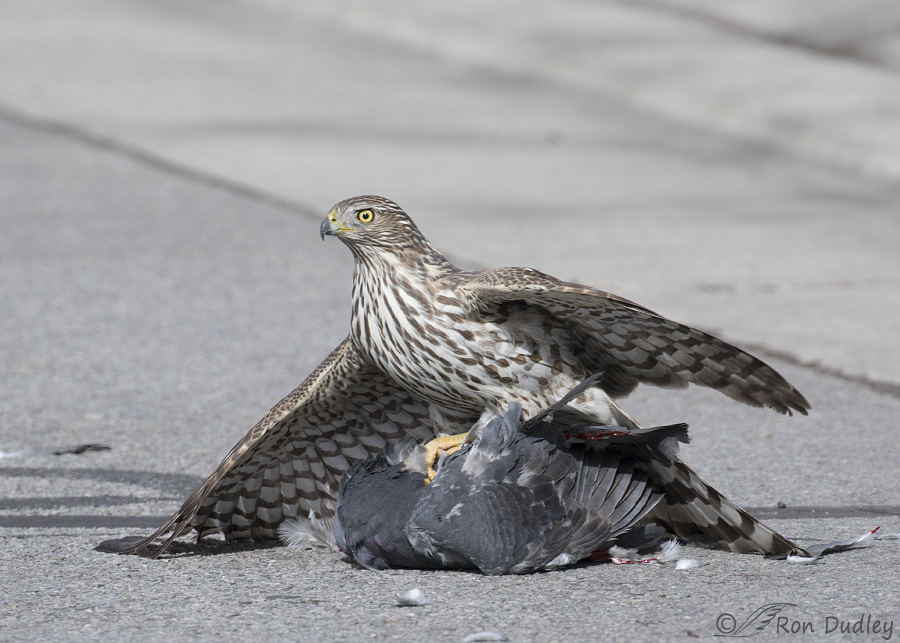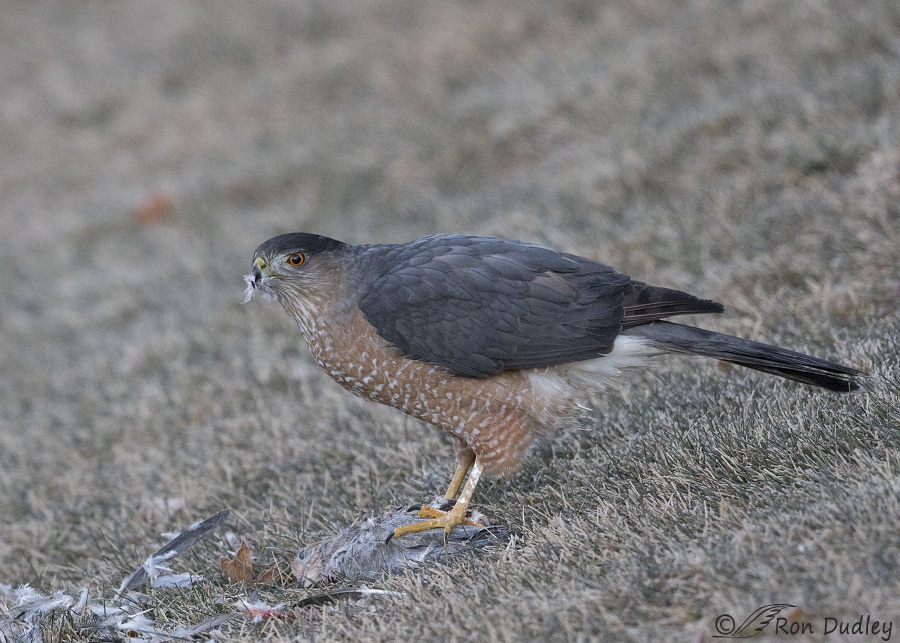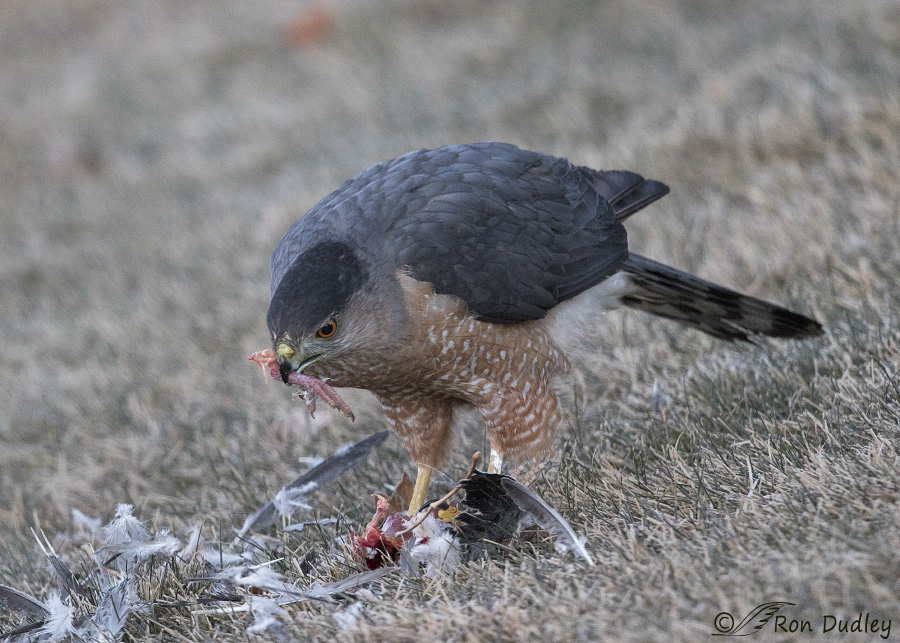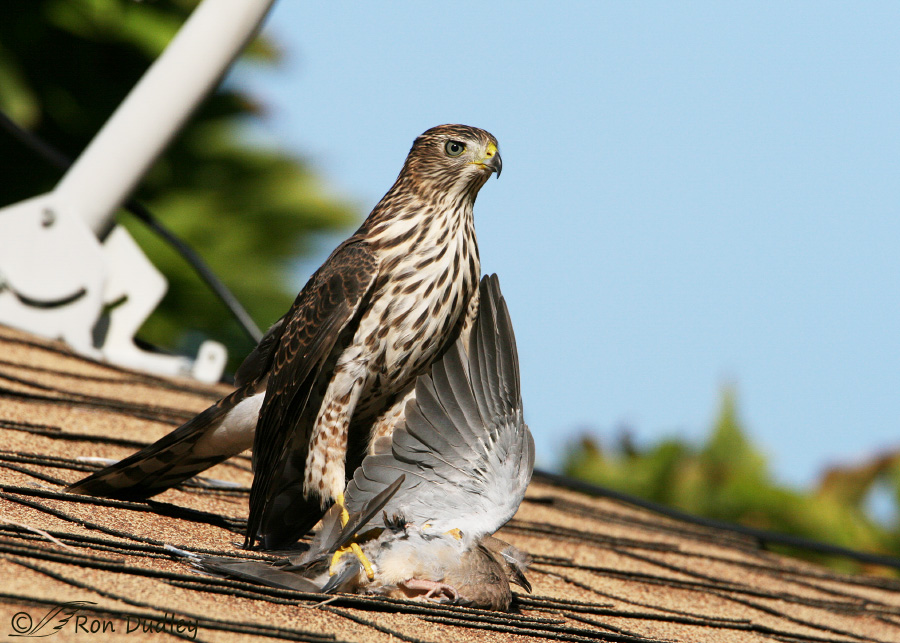Several comments on yesterday’s post (from James Marsh and Louise Shimmel in particular) about the value of wildlife in urban landscapes were the inspiration for today’s post.
Readers know that for my photography I prefer natural settings but I love seeing wildlife anywhere and that includes urban landscapes. As I pondered yesterday’s discussion my thoughts eventually turned to the Cooper’s Hawks I’ve photographed in my own yard and neighborhood over the years and I thought at least some of my readers might enjoy seeing photos I’ve taken of these accipiters where the settings include pavement, mowed lawns and even roofing shingles.

1/1600, f/7.1, ISO 320, Canon 7D Mark II, Canon EF 100-400mm f/4.5-5.6L IS II USM @ 400 mm, not baited, set up or called in
On March 10 of this year as I was I was driving through my neighborhood on my way to buy groceries I found this Cooper’s Hawk on a freshly killed pigeon on the side of the road. For security reasons I never carry my most expensive camera gear with me when I have to leave my pickup but I always carry my smaller zoom lens and it sure came in handy on this occasion.
Because I was worried about this hawk being on the road I deliberately got quite close to it and flushed it to a safer spot but pigeons are very large prey for this species and it really struggled to carry the pigeon in flight. It managed but just barely. This is a juvenile female and that’s a good thing because I’m sure a much smaller male would never have been able to become airborne with the heavy pigeon and it would have been reluctant to leave the street without it (which would have been a recipe for disaster on that busy street).

1/320, f/5, ISO 2000, Canon 7D Mark II, Canon EF 500mm f/4L IS II USM, not baited, set up or called in
On mornings when I go out photographing birds I usually leave in the dark to arrive at my destination by dawn and January 1, 2016 was no exception. I had only driven a few feet from my driveway before we spotted this adult Cooper’s Hawk finishing off a Mourning Dove on a neighbor’s lawn. It was so dark I almost didn’t even attempt to take photos but you know me…

1/125, f/5.6, ISO 2500, Canon 7D Mark II, Canon EF 500mm f/4L IS II USM , + EF 1.4 III Extender, not baited, set up or called in
The hawk seemed to pay particular attention to the dove’s leg and foot but to be honest I can’t remember if it was discarded or swallowed.
This was the soonest I’ve ever photographed a bird after leaving my house on a bird photography trip. I hope my early success that morning was a harbinger of things to come later in the day but to be honest that’s something else I can’t remember. Gettin’ old you know…

1/2000, f/8, ISO 400, Canon Digital Rebel XTi, Canon EF 500mm f/4L IS USM + EF 1.4 Extender, not baited, set up or called in
For a variety of reasons this was an incident I’ll never forget.
Back in July of 2007 I was an absolute beginner at bird photography. I’d only had my brand new 500mm lens for a few days so I had it set up on my tripod (also brand new) in my back yard as I worked in my vegetable garden, hoping to gain some experience with my new gear if an interesting bird appeared while I was working.
Suddenly I heard a “whoomph” sound and when I looked up this Cooper’s Hawk with a struggling Mourning Dove in its talons dropped out of the sky and landed nearly at my feet in the garden, only about 10′ away from where I was standing with my mouth hanging open in astonishment. The hawk and I stared at each other for a few moments and then as I slowly backed off toward my nearby camera and lens on the tripod the hawk flew with the dove to my roof where I was able to get a few shots with my ugly TV satellite dish in the background.
This was a very poignant scene. The dove’s wing is in a vertical position and its head is slightly off the roof because the bird is still (barely) alive and in its death throes. I watched through my lens as the wing slowly descended to a relaxed position as the dove died. Seeing it die so dramatically was difficult for me and it once again impressed on me the reality of the struggle for survival.
So yes, I do appreciate the opportunities for survival that urban and suburban habitats can provide for our wild critters and I enthusiastically support programs like the National Wildlife Federation’s Certified Wildlife Habitat Program in urban and suburban neighborhoods.
That said, I still prefer natural settings for my photography.
Ron


It is always interesting to note how much nature is in one’s own backyard (sometime’s literally!). Lately, I’ve been watching the flock of green parrots that hang around the college and cursing the day that we took out the coral trees which used to attract them to our yard.
It is tough to watch prey and not feel something for their plights. That’s one of the reasons I didn’t replace my (given to me by a student) classroom snake when he passed away. Giving my reptiles crickets and worms is one thing; mice and rats are quite another.
It’s funny how our empathy is relative in ways that sometimes aren’t logical, isn’t it, Marty. I’ve had some of the same reactions while feeding classroom critters and even seeing predator/prey relationships in the wild.
Wonderful photos! I especially love seeing the feather pattern on the under side of the wings on the first photo. My husband saw a Prairie Falcon take down a Great-tailed Grackle on the roof of our neighbor across the street’s house. By the time I saw it, the Falcon had the Grackle on the ground and was enjoying its meal. It was wonderful to be able to see that. Your photos and all of our experience show that it’s critical to be observant no matter where you are, or you will miss out on something good.
Your last sentence says it all, Susan. Thank you.
Love your “urban ” pictures! Reminds me to keep my eyes open even while driving to the store . Purists reject any picture with “the hand of man”. But I figure if Red-tailed hawks choose telephone poles , that’s their “choice” not mine.Thanks, John
John, Over the years I’ve learned to be on the lookout no matter where I go. It doesn’t happen often but occasionally there are some incredibly interesting wildlife interactions that can be seen (and photographed) almost anywhere.
And who are we to quibble with their choices?
I suspect the wildlife is less picky than you are about its location. Survival is the key. Just the same, I prefer to see them ‘where they belong’ knowing that they belong everywhere.
And I know that they kill to live. I accept that they kill to live. I just have difficulty watching. And will rush out (with my pump-action water pistol) when they are killing my garden. Colour me inconsistent.
You’re absolutely right about that inconstancy, EC.
And I now have an image in my mind of you scurrying around your garden with one of those brightly-colored water pistols and blasting away – an image I’m thoroughly enjoying at the moment…
LOL…and EC’s probably in her nightgown and slippers. Now THERE’S an image! Add in old-fashioned hair curlers and there’s a comedy movie…LOL!
Nearly right. Bare-feet and dressing gown. The neighbours are accustomed to mad woman with camera dances in the early morning. Mad woman with bubble blower in chilly winter dawns. Mad woman with water pistol they take in their stride.
I KNEW it EC, sister madwoman! There are perks to being a geezer and the madwoman thing is a particular delight! I raise a cackle to you!
I just love these images. While I don’t have the temperament or personality to fly a Cooper’s (or a sharpie or goshawk for that matter), I still admire their outrageous beauty. I once helped another falconer condition his female Cooper’s (The Babe) for her next hunting season, I was literally gobsmacked at the color gray on her head. The ONLY way I can describe it is it had a quality of gray that I’d never seen, never even contemplated before in my life. I had no idea that quality of gray was even possible, and yet, there it was, tinged with silvers and golds with a few oranges thrown in there in the sunlight. WOW! I’ll never be able to adequately describe that color. All I could do was stare at it in wonder and sheer awe (when she had her head turned, of course–I’m no dummy. LOL!).
Then, there are those eyes, so intense–the eyes of a killer holding no mercy, no compassion, but at the same time, no evil. What amazing dichotomies! In HER world, it is neither right, nor wrong. It just IS.
I used to struggle with the concept of killing within falconry until I realized that was MY (human) thing, which was mostly dishonest since I have no trouble eating hamburgers, steak, chicken or any other living thing. I was just falsely removed from the reality of my meals. I didn’t have to work for it, struggle with it and literally put my life on the line for it. And when I’m hunting with a raptor, I have to step outside my reality (my human world) and into a whole ‘nother world where I am nothing more than a visitor–or at worst, an intruder. I must respect the rules in The Great Out There where survival is paramount for both predator and prey. It’s truly humbling in a magical way that I can’t adequately put into words, either.
I SO love your work! I don’t want you to forget THAT, so I keep reminding you, ridiculous redundancy be damned
Oh here’s a Cooper’s hawk thing. Did you know that they will often repeatedly puncture their prey, their feet working at the speed of a crazed sewing machine, working up and down the body? That’s another one of those things that had me gobsmacked!
“the eyes of a killer holding no mercy, no compassion, but at the same time, no evil”
I love the way you said that, Laura. Just perfect!
I actually read about that “puncturing” strategy just today, on BNA Online I believe.
That puncturing thing is fun to watch, but you can’t REALLY see it since our eyes don’t work that fast! I love raptors (who’d know?)! They’re just SO darn cool!
We get a wide variety of wildlife around my home, but then we have Red Butte creek running behind my yard. Since the city cleaned out the creek gully of old growth and underbrush 2 years ago, we have less wildlife. I feed the songbirds and quail and inadvertently thus feed the Coopers, Redtail, Sharp shinned and Kestrels. Because our location is bird friendly, I get the luxury of releasing birds in my yard and “gully” from the rehab. The only wildlife I get a little annoyed with, due to the great numbers, is raccoons. I have to predator proof my outside mew from the crafty critters. For years I had a porcupine eating my flowers. I still have a few spines it shed in my yard.
Sounds like you live in an interesting area, April.
Many years ago I released a porcupine (it had been on my front porch in Sugarhouse of all places) in Red Butte Canyon. Terry Tempest Williams was with me when I did it and it was a wonderful experience for both of us.
LOL maybe the same animal wandered back into my yard. We saw it 1989 through 1993.
Hmmmm, that timing is interesting, April.
Keep your eye out for tomorrow’s post. If things work out I think you’ll be interested in it…
April, did you know you could take those porcupine quills and do an interesting embroidery with them? A friend of mine made me a lovely porcupine-quill embroidered medicine bag with the spider, a favored critter of the Osage nation. It’s just gorgeous! That said, my German shorthair (Reba the Silly Bird Dog) got into an altercation with a porcupine and that wasn’t fun at all. YIKES!
Ron, that sounds like a really fun time!
These are very graphic shots…clearly showing the relationship between the hawks and their prey…and the struggle we all face to survive. Once again, I find myself cringing at the plight of the prey while aknowledging that they are enabling the predator to survive…even so, it’s tough to witness….
Yes it is tough, Patty – especially up close through a long lens. In that situation it becomes quite personal, even intimate.
Great shots Ron! Love the documentation you do along with the artistry!
We are more suburban for a rural state, but open enough that Cooper’s have decided the Rock Pigeons we have here in this community are fair game. However, convinced they are successful maybe 10% of the time.
Pigeons are fast flyers and pretty big for many Cooper’s (especially smaller males) so I’ll bet they often think twice before taking one on, Dick. Hunger is a great motivator though….
Do you know whether Cooper’s will feed on a dead pigeon?
Last week a Pigeon hit our window suddenly due to ? and died later in the day. Next AM the head was gone. Next AM only feathers. I thought it might have been an Owl that took the head, but other than a mammal haven’t a clue who would have taken the carcass, but for a few feathers. Any thoughts?
Dick, I don’t know if they’ll feed on carrion or not. BNA says they will cache food and return to it during the breeding season but they don’t mention feeding on carrion.
Ron, the food they cache would be de facto carrion. Personally, I think all the raptors will eat carrion when necessary. After all, it’s free food and free food is always good in raptor land.
Thanks Laura. We had just below freezing temperatures those two days. However, during the day (I wasn’t watching but every once in awhile) the pigeon was there, next morning was when I noticed changes. What got me was that by the second day only a few feathers were scattered about. Almost like it was picked up and carried away.
That’s a good bet Dick. I’ve noticed that accipiters really like to de-feather, de-fur their meals before eating, but a head/neck is one of the delectable parts, just about equal to the cool innards
The Coops around me have learned to spook doves into windows. Doves are easily spooked, so the hawk waits until one flies by and then chases with the intent of panicking the prey. When the dove hits the window and falls to the ground. the little raptor casually claims his foolish prize and proceeds to pluck. I’m sure they chortle to themselves over being so clever.
Damned smart birds (the Coops, not the doves…).
I understand, but for me I’d rather think your Coops have learned to use human habitation for helping to procure food.
Maybe I’m watching evolution in plain sight! VBG!
Yes I always struggle when the hawks catch my tweety birds as I call them. But I suppose they have to eat also.. but I still struggle.. it’s like why can’t hawks eat seeds ??? But than I eat meat also and don’t have to. In the summer I do chase them off when I see them because they pluck the baby birds out of they’re nests and parents are defenseless to do anything.. but in winter the odds even out and I leave the Hawks alone ..
Personally I’ve never really had a problem with natural cycles whether they be carnivorous or herbivorous. That said, watching a difficult or slow death still isn’t easy for me.
Good captures Ron even if not in your preferred locations……..:) The Urban landscape with wildlife in it does provide “city folks” with a bit of nature at times even if a bit gruesome or, in the case of deer/coyotes frustration over the problems they can cause. It does remind of the adaptability of wildlife to the “problems” we create for them. It is also an opportunity for photographers and others who can’t get to the wild places to get photographs of them. Thx for the reminder of that!
Judy, I’m glad that at least some of our wild critters are much less picky about where they live than I am about where I prefer to photograph them. Adaptability and flexibility are key, especially these days.